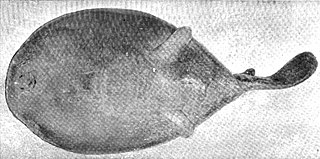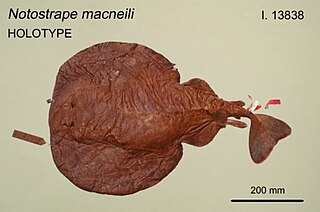
The electric rays are a group of rays, flattened cartilaginous fish with enlarged pectoral fins, composing the order Torpediniformes. They are known for being capable of producing an electric discharge, ranging from 8 to 220 volts, depending on species, used to stun prey and for defense. There are 69 species in four families.

The family Torpedinidae contains 22 species of electric rays or torpedoes, flat cartilaginous fishes that produce electricity as a defense and feeding mechanism. They are slow-moving bottom-dwellers.
The New Zealand catshark, Bythaelurus dawsoni, is a catshark of the family Scyliorhinidae in the order Carcharhiniformes. This species is endemic to in the deep waters around New Zealand. Its length is up to 45 centimetres (18 in). The New Zealand catshark is a small, little-known deep water bottom shark. It is dark brown around the top with a few widely spaced pale spots, and white below. It feeds on bottom-living crustaceans. It is also completely harmless to humans.

The thorntail stingray, black stingray, or longtail stingray is a species of stingray in the family Dasyatidae. It is found off southern Africa, Australia, and New Zealand from the intertidal zone to a depth of 440 m (1,440 ft). This bottom-dweller inhabits soft-bottomed habitats such as lagoons, estuaries, and reefs. Growing to 1.8 m (5.9 ft) across and over 200 kg (440 lb) in weight, the thorntail stingray is among the largest stingrays in the world. Uniformly dark above and light below, it has a diamond-shaped pectoral fin disc and a very long, whip-like tail with a fin fold underneath. The upper surface of the disc and the tail bear numerous stout, sharp thorns.

The oval electric ray is a little-known species of sleeper ray in the family Narkidae. It is endemic to New Zealand, where it is generally found on the sea floor at a depth of 300–400 m (980–1,310 ft). Seldom exceeding 30 cm (12 in) in length, this species has a thick, oval pectoral fin disc and a short, stout tail with a single dorsal fin. It is blind, as its tiny eyes are covered by skin. Its pelvic fins are divided in two, with the anterior portion forming a limb-like appendage. These appendages likely allow the ray, which may not be able to swim at all, to "walk" along the bottom. The claspers of adult males extend beyond the disc. Polychaete worms are known to be part of its diet, and its reproduction is aplacental viviparous. It can produce an electric shock for defense. The International Union for Conservation of Nature presently lacks the data to assess its conservation status.

The draughtsboard shark is a species of catshark, and part of the family Scyliorhinidae, so named for its "checkerboard" color pattern of dark blotches. It is endemic to New Zealand, where it is also known as the carpet shark. This shark typically reaches 1 m (3.3 ft) in length and has a thick body with a broad, flattened head and a capacious mouth. Its two dorsal fins are placed far back on the body, with the first much larger than the second.

Torpedo is a genus of rays, commonly known as electric rays, torpedo rays, or torpedoes. They are slow-moving bottom-dwellers capable of generating electricity as a defense and feeding mechanism.

The Florida torpedo is a rare and little-known species of electric ray in the family Torpedinidae. It is known only from two specimens and a some wild sightings. Torpedoes have been recorded from three scattered locations in the Florida Straits and the western Caribbean Sea, and appear to inhabit coral habitats.

The black-spotted torpedo, Torpedo fuscomaculata, is a poorly known, uncommon species of electric ray in the family Torpedinidae, known for being capable of generating an electric shock. It is endemic to southern Africa and possibly several small Indian Ocean islands, although the latter reports may represent undescribed new species. Its appearance is similar to the Gulf torpedo, but it is duller in coloration.

Torpedo panthera also known as the leopard torpedo is a species of fish in the family Torpedinidae. It is found in Djibouti, Egypt, Eritrea, India, Iran, Oman, Pakistan, Saudi Arabia, Somalia, Sudan, and Yemen. Its natural habitat is open seas.
Tetronarce puelcha, commonly known as the Argentine torpedo, is a species of fish in the family Torpedinidae. It is found in Argentina, Brazil, and Uruguay. Its natural habitat is open seas. It is rare electric ray fish species, which is moderately large (104 cm) found in South West Atlantic.

The Gulf torpedo or variable electric ray is a species of electric ray in the family Torpedinidae. It is found in the Indian Ocean, but may represent a species flock of several local endemic species. It is distinguishable from other Torpedo species in its range by its ornate dorsal coloration. Another common name, marbled electric ray, is not to be confused with Torpedo marmorata.
Tetronarce tremens, commonly known as the Chilean torpedo, is a species of fish in the family Torpedinidae. It is found in Chile, Colombia, Costa Rica, Ecuador, and Peru. Its natural habitat is open seas.

The common torpedo, also known as ocellate torpedo or eyed electric ray, is a species of electric ray in the family Torpedinidae. It is found in the Mediterranean Sea and the eastern Atlantic Ocean from the Bay of Biscay to Angola, and is a benthic fish typically encountered over soft substrates in fairly shallow, coastal waters. Growing to 60 cm (24 in) long, this species has a nearly circular pectoral fin disc and a short, thick tail with two dorsal fins of nearly equal size and a large caudal fin. It can be identified by the prominent blue spots on its back, which usually number five but may vary from zero to nine, as well as by the small knobs on the rims of its spiracles.

The Atlantic torpedo is a species of electric ray in the family Torpedinidae. It is found in the Atlantic Ocean, from Nova Scotia to Brazil in the west and from Scotland to West Africa and off southern Africa in the east, occurring at depths of up to 800 m (2,600 ft). Younger individuals generally inhabit shallower, sandy or muddy habitats, whereas adults are more pelagic in nature and frequent open water. Up to 1.8 m (6 ft) long and weighing 90 kg (200 lb), the Atlantic torpedo is the largest known electric ray. Like other members of its genus, it has an almost circular pectoral fin disk with a nearly straight leading margin, and a robust tail with a large triangular caudal fin. Distinctive characteristics include its uniform dark color, smooth-rimmed spiracles, and two dorsal fins of unequal size.

The blind electric ray is a little-known species of sleeper ray in the family Narkidae, endemic to New Zealand. It is found on the bottom, typically at a depth of 300–400 m (980–1,310 ft). Reaching 38 cm (15 in) in length, this species has a thin, nearly circular pectoral fin disc without visible eyes, and a short tail with a single dorsal fin. Its pelvic fins are divided in two, with the anterior portion forming a limb-like appendage; in males the claspers do not extend past the disc margin. A weak swimmer, the blind electric ray likely pushes itself along using its pelvic fins. It is known to feed on polychaete worms, and can defend itself with an electric shock. Reproduction is aplacental viviparous. The International Union for Conservation of Nature (IUCN) does not have enough information to assess the conservation status of this species.

The Japanese sleeper ray is a species of electric ray in the family Narkidae. It is common in the inshore and offshore waters of the northwestern Pacific Ocean from southern Japan to southern China. Growing up to 40 cm (16 in) long, the Japanese sleeper ray has a nearly circular pectoral fin disc colored reddish to chocolate brown above, sometimes with darker or lighter spots, and lighter brown below. The spiracles behind its small eyes have raised, smooth rims. Its short and muscular tail bears a single dorsal fin positioned aft of the rounded pelvic fins, and terminates in a large caudal fin.

Tetronarce is a genus of rays, commonly known as electric rays. They are slow-moving bottom-dwellers capable of generating electricity as a defense and feeding mechanism. Tetronarce species tend to attain a much larger size than Torpedo species, which are usually small to moderate sized electric rays.

Tetronarce macneilli, commonly known as the Shorttail torpedo, is a species of large electric ray. The taxonomy of the species has been long debated and has been suggested that it is synonymous with Torpedo fairchildi.
Torpedo mackayana, commonly known as the ringed torpedo, Western African torpedo, West African torpedo ray, McKay electric ray, or McKay's torpedo ray, is an electric ray species in the family Torpedinidae, which lives in shallow waters on the western coast of Africa. Characterized by rounded spiracles and white and brown spots, females grow to 35–50 centimetres (14–20 in) and males to 31.5–38.2 centimetres (12.4–15.0 in).















